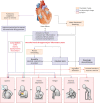End-of-Life Care for End-stage Heart Failure Patients
- PMID: 36097835
- PMCID: PMC9470494
- DOI: 10.4070/kcj.2022.0211
End-of-Life Care for End-stage Heart Failure Patients
Abstract
Efforts to improve end-of-life (EOL) care have generally been focused on cancer patients, but high-quality EOL care is also important for patients with other serious medical illnesses including heart failure (HF). Recent HF guidelines offer more clinical considerations for palliative care including EOL care than ever before. Because HF patients can experience rapid, unexpected clinical deterioration or sudden death throughout the disease trajectory, choosing an appropriate time to discuss issues such as advance directives or hospice can be challenging in real clinical situations. Therefore, EOL issues should be discussed early. Conversations are important for understanding patient and family expectations and developing mutually agreed goals of care. In particular, high-quality communication with patient and family through a multidisciplinary team is necessary to define patient-centered goals of care and establish treatment based on goals. Control of symptoms such as dyspnea, pain, anxiety/depression, fatigue, nausea, anorexia, and altered mental status throughout the dying process is an important issue that is often overlooked. When quality-of-life outweighs expanding quantity-of-life, the transition to EOL care should be considered. Advanced care planning including resuscitation (i.e., do-not resuscitate order), device deactivation, site for last days and bereavement support for the family should focus on ensuring a good death and be reviewed regularly. It is essential to ensure that treatment for all HF patients incorporates discussions about the overall goals of care and individual patient preferences at both the EOL and sudden changes in health status. In this review, we focus on EOL care for end-stage HF patients.
Keywords: End of life; Heart failure; Palliative care.
Copyright © 2022. The Korean Society of Cardiology.
Conflict of interest statement
The authors have no financial conflicts of interest.
Figures


References
-
- Dunlay SM, Foxen JL, Cole T, et al. A survey of clinician attitudes and self-reported practices regarding end-of-life care in heart failure. Palliat Med. 2015;29:260–267. - PubMed
Publication types
LinkOut - more resources
Full Text Sources
Research Materials
Miscellaneous

